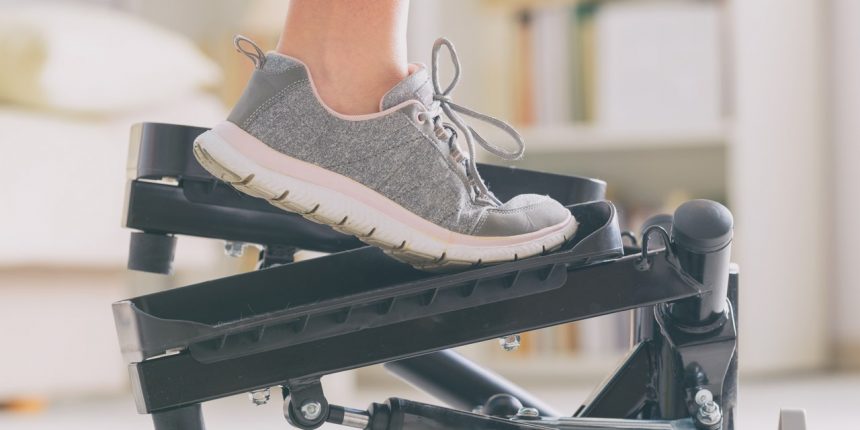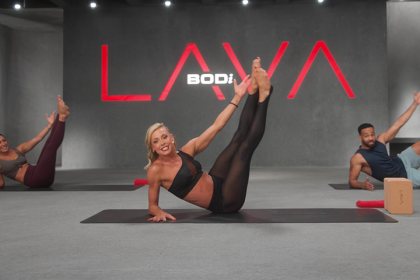All products are independently selected by our editors. If you buy something, we may earn an affiliate commission.
Scroll through GymTok, and you can’t miss the newest darling of at-home fitness equipment: the mini-stepper. Looking like a love child between an elliptical and a StairMaster—your feet stay on the pedals the whole time, but just go straight up and down rather than in arcs—the viral gadget is compact, portable, and typically pretty budget-friendly.
Plus, there’s really no learning curve; you basically just hop on and start stepping. All this explains why bouncing fitfluencers are singing its praises, touting its ability to get their heart pumping and legs burning.
But do actual fitness experts agree? We connected with personal trainers to see whether you actually can get a legit workout with this pint-size piece of equipment. Here’s what you need to know before entering your credit card info on the TikTok shop.
Mini-steppers can give you a low-impact cardio workout.
Whether you’re taking a work call at home or watching TV, hopping on a mini-stepper while you’re at it can add a little low-impact cardio to your day when you otherwise might have been lounging. Trainers say this simplicity and accessibility can help people stay consistent with their daily movement goals, particularly if they’ve got limited space at home (or time to head to the gym). “It’s a great alternative to the walking pad,” Lindsey Bomgren, NASM-CPT, founder of online fitness platform Nourish Move Love, tells SELF.
Once you step on, you’ll quickly feel your glutes, quads, hamstrings, and calves kick in, and, since there’s nothing to hold onto—these machines don’t have any handrails—your core will also fire up to keep you balanced, Bomgren says. And because you’ll be constantly stepping, your heart rate will hit those moderate or even vigorous intensity zones (depending on how fast you’re going) too.
Sounds like what you can expect from an elliptical or stair climber, right? Similar, yes, but not exactly. It’s difficult to get quite as effective of a cardio workout as you could on a full-size elliptical or stair climber since it’s hard to move as intensely as you could on a sturdier piece of equipment that has handrails to grab onto. Plus, although you can obviously switch up how fast you’re pedaling on a mini-stepper at any time, to change the resistance, you typically have to get off the machine and turn a knob, which doesn’t exactly let you hit a flow state. In comparison, most full-length machines not only let you manually adjust these settings as you go, but many also come with preset workout routines like hills and intervals to guide you through an effective cardio workout.
And like with any piece of cardio equipment, if that’s all you’re using, you won’t be building well-rounded fitness. Only using a mini-stepper “misses strength training,” Bomgren points out—and the benefits that come with it. While some machines do come with resistance bands that you can attach to get your upper body in on the action, too, what you can do with those while stepping is pretty limited. (More on that, below.)
How can you get in a good workout with a mini-stepper?
You can use it to get a balanced workout; you just need to get a little creative. Richard Sanchez, NASM-CPT, a personal trainer for Crunch Fitness in New York City, recommends using a mini-stepper as just one part of a circuit training session. For instance, he suggests incorporating it into a kettlebell routine. “Maybe I would do two minutes at a high [effort] interval on the stepper,” he tells SELF. “And then go right into a kettlebell complex of an overhead raise, into a squat, into a single-leg reverse lunge for both sides.” Repeat that six times, and you’ve got yourself a high-powered half-hour workout. (The exact moves can vary, but you’d want to choose compound exercises that recruit big muscle groups and target different parts of your body.) If you don’t have a kettlebell (or other free weights) at home, you can sub in calisthenics exercises instead.
Although you might be tempted to add in some bicep curls with those attachable resistance bands to get the most bang for your workout buck while you’re on the mini-stepper, Bomgren says you’re better off focusing on doing strength work after you’ve hopped off.
Trying to work out your arms while stepping could be a bit too complex for beginners to pull off effectively. “Typically, there’s a natural arm swing that you want to complement your stride,” Sanchez points out. If you struggle with coordination, ditching that swing to add something like curls while stepping could be too much to handle. And multitasking means you won’t be putting your total focus (and energy) into your strength moves, so you won’t get as much out of them.
What’s more, it’s simply not the most effective way of strength training, Bomgren says—most of the moves you can do on a stepper “keep you in one plane of motion, and life is three-dimensional.” She prefers more functional strength training by working with free weights to move in all planes of motion—say, by incorporating moves like halos, wood chops, and lateral raises.
So are mini-steppers worth the hype?
This viral trend has its merits—and its limits. “Any type of movement is good movement,” Bomgren says. “I just think that you would see greater benefits from an elliptical or a stair stepper.”
If you’re tempted to buy a mini-stepper, just be sure the weight capacity will support everyone at home who wants to use it. The popular Sunny Health & Fitness mini stepper, for instance, only supports users up to 220 pounds, while KeppiFitness sells one with a 350-pound capacity. Bomgren also recommends looking for one with a wide base to make sure it’s stable enough to step as fast as you want to.
Along that vein: If you’re really worried about your balance, you might want to skip the mini-stepper altogether and invest in full-size home gym equipment (with handrails) that might be pricier but will be more likely to keep you safe. (Alternatively, if you just need a little extra support, both trainers recommend placing your mini-stepper near a dresser or counter that you can grab onto if you need.)
More than anything, ask yourself whether it’s going to end up in a corner getting dusty. Because, as Sanchez says, “the biggest key is consistency.” Just like any fitness tool, the only way to get something out of the mini-stepper is to actually use it.
Related:
- Does Rowing ‘Count’ as Strength Training—Or Is It Just a Cardio Workout?
- Is It Better to Do Cardio Before or After Weights?
- This Low-Impact Cardio Workout Will Actually Get Your Heart Rate Up
Get more of SELF’s great fitness coverage delivered right to your inbox—for free.







